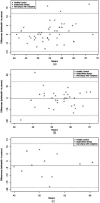Remote Assessment of Pediatric Patients with Daytime Sleepiness and Healthy Controls: A Pilot Study of Feasibility and Reliability
- PMID: 34660839
- PMCID: PMC8512221
- DOI: 10.1177/2329048X211048064
Remote Assessment of Pediatric Patients with Daytime Sleepiness and Healthy Controls: A Pilot Study of Feasibility and Reliability
Abstract
We assessed the reliability of cognitive testing for children and adolescents ages 8 to 19 years of age with narcolepsy or subjective daytime sleepiness compared to healthy controls. Forty-six participants took part in the study (n = 18 narcolepsy type 1, n = 6 subjective daytime sleepiness, and n = 22 healthy controls). Participants completed verbal (vocabulary testing) and non-verbal intelligence quotient (IQ) tasks (block design, matrix reasoning) from the Wechsler Abbreviated Scale of Intelligence- Second Edition (WASI-II) in-person or remotely through a HIPAA compliant telehealth platform with conditions counterbalanced. We found that vocabulary T-scores showed good reliability with intraclass correlation coefficient (ICC) of 0.76 (95% CI: 0.64, 0.85) between remote and in-person testing conditions. Matrix Reasoning T-scores showed moderate reliability (ICC 0.69, 95% CI: 0.68, 0.90) and Block Design T-scores was poor between testing conditions. Overall, the results of this pilot study support the feasibility and reliability of verbal and non-verbal IQ scores collected by telehealth.
Keywords: Telehealth; cognition; excessive daytime sleepiness; intelligence quotient (IQ); narcolepsy.
© The Author(s) 2021.
Conflict of interest statement
Declaration of Conflicting Interests: The author(s) declared no potential conflicts of interest with respect to the research, authorship, and/or publication of this article.
Figures

Update of
-
Remote Assessment of Cognition in Kids and Adolescents with Daytime Sleepiness: A pilot study of feasibility and reliability.medRxiv [Preprint]. 2021 Mar 26:2021.03.24.21254190. doi: 10.1101/2021.03.24.21254190. medRxiv. 2021. Update in: Child Neurol Open. 2021 Oct 11;8:2329048X211048064. doi: 10.1177/2329048X211048064. PMID: 33791741 Free PMC article. Updated. Preprint.
Similar articles
-
Remote Assessment of Cognition in Kids and Adolescents with Daytime Sleepiness: A pilot study of feasibility and reliability.medRxiv [Preprint]. 2021 Mar 26:2021.03.24.21254190. doi: 10.1101/2021.03.24.21254190. medRxiv. 2021. Update in: Child Neurol Open. 2021 Oct 11;8:2329048X211048064. doi: 10.1177/2329048X211048064. PMID: 33791741 Free PMC article. Updated. Preprint.
-
Validation of the Epworth Sleepiness Scale for Children and Adolescents (ESS-CHAD) questionnaire in pediatric patients with narcolepsy with cataplexy aged 7-16 years.Sleep Med. 2022 Jan;89:78-84. doi: 10.1016/j.sleep.2021.11.003. Epub 2021 Nov 11. Sleep Med. 2022. PMID: 34920345
-
Visual orientation discrimination skills are tightly linked with specific aspects of human intelligence.PLoS One. 2023 Oct 17;18(10):e0289590. doi: 10.1371/journal.pone.0289590. eCollection 2023. PLoS One. 2023. PMID: 37847685 Free PMC article.
-
[Assessments of sleepiness in adolescents: A key tool for better intervene in mental health].Sante Ment Que. 2023 Spring;48(1):95-120. Sante Ment Que. 2023. PMID: 37862255 Review. French.
-
Pitolisant versus placebo for excessive daytime sleepiness in narcolepsy and obstructive sleep apnea: A meta-analysis from randomized controlled trials.Pharmacol Res. 2021 May;167:105522. doi: 10.1016/j.phrs.2021.105522. Epub 2021 Mar 2. Pharmacol Res. 2021. PMID: 33667687
Cited by
-
Feasibility of Remote Performance Assessment Using the Free Research Executive Evaluation Test Battery in Adolescents.Front Psychol. 2021 Oct 14;12:723063. doi: 10.3389/fpsyg.2021.723063. eCollection 2021. Front Psychol. 2021. PMID: 34721181 Free PMC article.
-
Impaired sleep-dependent memory consolidation in pediatric narcolepsy type 1.Sleep. 2025 Feb 10;48(2):zsae238. doi: 10.1093/sleep/zsae238. Sleep. 2025. PMID: 39420719
References
Grants and funding
LinkOut - more resources
Full Text Sources

